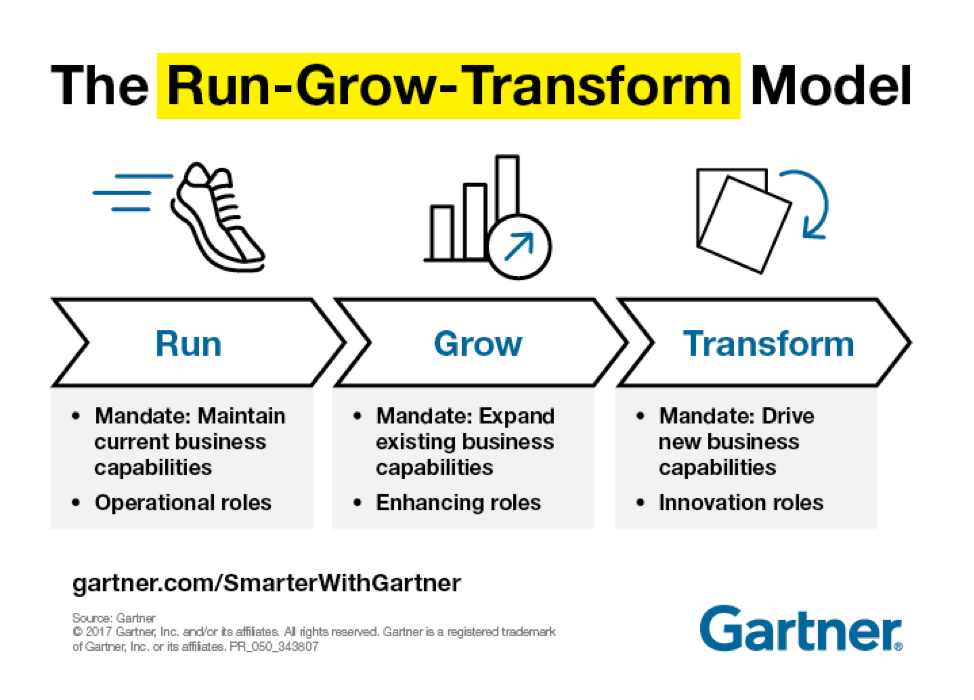
Today’s technology is amazing. And what will come in the future will probably blow our minds. But as much as we love new tech, we are committed to delivering only responsible IT solutions for our clients. No question. Technology in any business scenario has to be purposeful. Technology for technology’s sake just isn’t an option.
To us, it is critically important for technology to align with our clients’ business goals, or the tech investment is scattered and the business suffers in the end. Today’s CIOs and tech managers have had to transition from a “run costs” way of operating to a strategic mentality. Technology initiatives are a critical component of driving business growth, no longer the backroom “business as usual” department.
“CIOs are under mounting pressure to address digital needs with “grow” and “transform” functions, as well as to renovate the operational environment with “run” functions. They also must still demonstrate how IT is meeting strategic business goals,” says Suzanne Adnams, research vice president at Gartner.
Ultimately, what all this means is that most of your IT budget should be spent on areas that drive revenue. That may be easier to ascertain in some businesses than others but revenue should be top of mind for almost every IT decision.
A Roadmap for Better Alignment
So, is there a roadmap or a good approach to aligning IT budgets with business goals? We’ve developed some processes and planning guides and share them here.
- Know when to let go. So many IT departments spend a significant portion of their budgets maintaining the status quo. That includes outdated systems that truly don’t support the business but they have been in place for a long time and it’s just an assumption that they need to be there. Not necessarily. In many situations, there are innovative solutions that could replace old products and actually work toward business growth.
- Update your IT roadmap. A roadmap should lay out your current IT situation including tech, functions and staff. This is usually a pretty dynamic document which will allow you to change due to market and business transitions. This is usually the place where the IT department includes their wish list for new tech. That’s fine but be sure that roadmap changes align with what’s happening with the business overall. Your priority should be to either accelerate or decelerate spending based on business activity.
- Focus on growth. Typically businesses with plans to grow revenue, market share and influence expand their product and services offering. To support these initiatives, CIOs must determine that their IT capabilities will perform appropriately. Usually, these growth strategies need increased budget for capital projects and technology upgrades. Essential growth functions include business process analysis, project management, solution and application architecture, and procurement.
- Change your view. CIOs are no longer just the keeper of smooth functionality; they are also being charged with determining new markets, generating revenue, delivering innovation and creating new services and solutions. Fortunately other C-level executives realize the power of technology and willingly work in partnership with IT departments to support digital transformations within the business. Today’s CIOs now get involved in capital investment management, research and development, business architecture, digital solutions and more.
- Account for disruption. This may seem like it’s unrelated to driving growth but it’s important to be realistic. In spite of all your best efforts on driving revenue, thinking ahead and working proactively, disruptions still occur. It can be anything from a power outage to a major weather event. This is just a fact of life for an IT department and your managed services provider can help you determine the allocation for this line item.
- Incorporate industry standards and compliance. Regulated businesses must accommodate meeting compliance requirements as part of the IT budget. Just be aware that if you are spending more on compliance than you are on IT business drivers, your IT budget may not be aligned with overall business goals.
The synergy between CIOs and other C-level execs is a positive move toward budgeting that’s both responsible and flexible to accommodate business growth. When the helicopter view of a business is in sight, it’s easy to see that IT has a huge impact on the future of any company. Real, sustainable business growth can only occur by looking at major strategic initiatives—instead of individual line items—and budgeting accordingly.
Also read:
